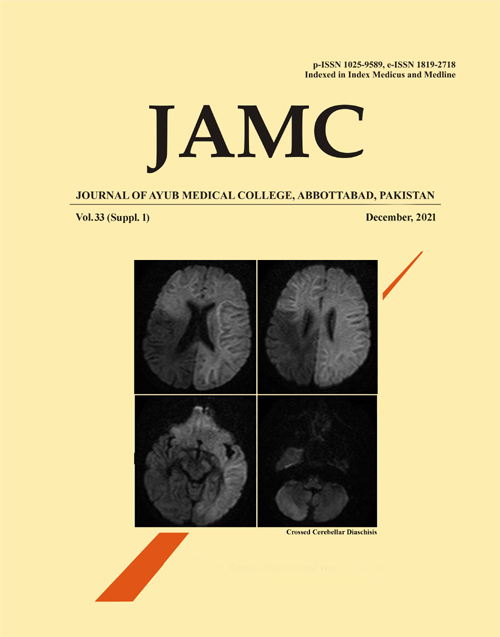MAYER-ROKITANSKY-KÃœSTER-HAUSER SYNDROME: MR MANIFESTAIONS OF TYPICAL AND ATYPICAL CASES
Abstract
Background: The Mayer-Rokitansky-Küster-Hauser (MRKH) syndrome is a group of congenital malformations arising due to agenesis or arrest of the growth of paired Mullerian ducts leading to absence of uterus, fallopian tubes and upper part of vagina. MRI has an unmatched role in diagnosing MRKH syndrome. The aim of the present study is to elaborate MRI manifestations of typical and atypical MRKH syndrome and its common and rare associations. Methods: It was a cross sectional analysis of 19 cases in the Radiology Department of a public sector tertiary health care hospital of Rawalpindi over a period of one year. All patients clinically diagnosed as MRKH syndrome were included in the study. MRI pelvis of the study patients was performed and evaluated by two experienced radiologists. Results: The mean age of study patients was 22.2 years. Out of 19 study patients, 16 (84%) had type I while 3 (16%) had type II MRKH syndrome. None of the patients had normally cited uterus of normal morphology. Bilateral ovaries with follicular activity were identified in all patients. A well-defined leiomyoma was identified arising from the left uterine bud in one of these patients. All three patients with MRKH II syndrome had ectopic pelvic kidneys. One of the patients showed a neoplastic mass lesion arising from ectopic left kidney. Conclusion: MRI is an excellent imaging modality for accurate diagnosis and evaluation of other system anomalies in MRKH syndrome. Rudimentary uterine buds are commonly seen in these patients and may have functioning endometrium. Ovaries are of normal appearance but frequently ectopic.
References
Herlin MK, Petersen MB, Brännström M. Mayer-Rokitansky-Küster-Hauser (MRKH) syndrome: a comprehensive update. Orphanet J Rare Dis. 2020;15(1):1-6.
Strübbe EH, Cremers CW, Willemsen WN, Rolland R, Thijn CJ. The Mayer-Rokitansky-Küster-Hauser (MRKH) syndrome without and with associated features: two separate entities? Clin Dysmorphol 1994;3(3):192-9.
Drews U, Sulak O, Schenck PA. Androgens and the development of the vagina. Biol Reprod 2002;67(4):1353-9.
Elumalai G, Arumugam M. Common vaginal anomalies embryological basis and its clinical importance. Elixir Embryol 2017;102:44498-501.
Morcel K, Guerrier D, Watrin T, Pellerin I, Levêque J. The Mayer-Rokitansky-Küster-Hauser (MRKH) syndrome: clinical description and genetics. J Gynecol Obstet Biol reprod (Paris) 2008;37(6):539-46.
Strubbe EH, Cremers CW, Willemsen WN, Rolland R, Thijn CJ. The Mayer-Rokitansky-KusterHauser (MRKH) syndrome without and with associated features: two separate entities? Clin Dysmorphol 1994;3(3):192-9.
Üstüner I, Keskin L, Öztürk Ö, Özyiğit E, Avşar AF. Mayer-Rokitansky-Kuster-Hauser (MRKH) sendromu. Yeni Tip Dergisi 2008;25:241-24.
Morcel K, Camborieux L, Guerrier D. Mayer-Rokitansky-Küster-Hauser (MRKH) syndrome. Orphanet J Rare Dis 2007;2(1):1-9.
Kara T, Acu B, Beyhan M, Gökçe E. MRI in the diagnosis of Mayer-Rokitansky-Kuster-Hauser syndrome. Diagn Interv Radiol 2013;19(3):227-32.
Sen KK, Kapoor A. Mayer- Rokitansky- Kuster- Hauser syndrome. Indian J Radiol Imaging 2006;16(4):805-7.
Girma W, Woldeyes W. Leiomyoma Arising from Mullerian Remnant, Mimicking Ovarian Tumor in a Woman with MRKH Syndrome and Unilateral Renal Agenesis. Ethiop J Health Sci 2015;25(4):381-4.
Narayanan R, Mariappan S, Paulraj S, Shankar B. Imaging of leiomyomas arising from Müllerian remnants in a case of Mayer-Rokitansky-Küster-Hauser syndrome. BMJ Case Reports 2015;2015:bcr2015210737.
Kundu K, Cohen AW, Goldberg J. Acute torsion of uterine remnant leiomyoma with Mayer-Rokitansky- Küster-Hauser syndrome. Fertil Steril 2014;102(2):607-9.
Petrić A, Stefanović M, Vukomanović P, Zivadinović R, Tubić A, Janjić Z. Acute abdomen in a patient with Mayer-Rokitansky-Kuster-Hauser syndrome. Vojnosanit Pregl 2008;65(9):706-9.
Lanowska M, Favero G, Schneider A, Köhler C. Laparoscopy for differential diagnosis of a pelvic mass in a patient with Mayer-Rokitanski-Küster-Hauser (MRKH) syndrome. Fertil Steril 2009;91(3):931.e17-8.
Dong Z, Leng J, Lang J. A rare case of MRKH with adenomyosis and literature review. Chin J Pract Gynecol Obstet 2009;25(12):936-7.
Boruah DK, Sanyal S, Gogoi BB, Mahanta K, Prakash A, Augustine A, et al. Spectrum of MRI Appearance of Mayer-Rokitansky-Kuster-Hauser (MRKH) Syndrome in Primary Amenorrhea Patients. J Clin Diagn Res 2017;11(7):TC30-5.
Downloads
Published
How to Cite
Issue
Section
License
Journal of Ayub Medical College, Abbottabad is an OPEN ACCESS JOURNAL which means that all content is FREELY available without charge to all users whether registered with the journal or not. The work published by J Ayub Med Coll Abbottabad is licensed and distributed under the creative commons License CC BY ND Attribution-NoDerivs. Material printed in this journal is OPEN to access, and are FREE for use in academic and research work with proper citation. J Ayub Med Coll Abbottabad accepts only original material for publication with the understanding that except for abstracts, no part of the data has been published or will be submitted for publication elsewhere before appearing in J Ayub Med Coll Abbottabad. The Editorial Board of J Ayub Med Coll Abbottabad makes every effort to ensure the accuracy and authenticity of material printed in J Ayub Med Coll Abbottabad. However, conclusions and statements expressed are views of the authors and do not reflect the opinion/policy of J Ayub Med Coll Abbottabad or the Editorial Board.
USERS are allowed to read, download, copy, distribute, print, search, or link to the full texts of the articles, or use them for any other lawful purpose, without asking prior permission from the publisher or the author. This is in accordance with the BOAI definition of open access.
AUTHORS retain the rights of free downloading/unlimited e-print of full text and sharing/disseminating the article without any restriction, by any means including twitter, scholarly collaboration networks such as ResearchGate, Academia.eu, and social media sites such as Twitter, LinkedIn, Google Scholar and any other professional or academic networking site.










